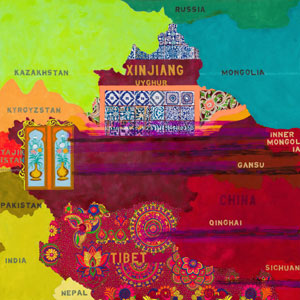8.28.24 — Like a Bomb
As a quiet summer nears its end, allow me a review that I somehow never got to post. If you remember Joyce Kozloff as a founder of what came to be known as “Pattern and Decoration,” you may wonder what she is doing with a show entirely of maps. They are contemporary maps at that, of regions torn apart by aggression and war.
They are recognizably hers all the same, with overlaid patterns that might themselves have been torn away, but from vintage wallpaper. They just happen to land at the site of unilaterally or mutually assured destruction. For once, the decorative arts land like a bomb. What might once have served as the comforts of art and home is now just one more part of the show’s “Collateral Damage,”  at D. C. Moore through this past February 3.
at D. C. Moore through this past February 3.
It may still leave you wondering. Like Miriam Schapiro and Valerie Jaudon, Kozloff came to the movement with a dedication to painting and a smile, not the anger of a world at war. Surely the decorative arts have a different time frame from the latest news in mind, whether the frivolity of fashion or timeless craft. While critics could easily dismiss such art as, well, feminine, Kozloff embraced the label. She appeared in “WACK” at MoMA PS1, then still P.S. 1 Contemporary Art Center, as part of a “feminist revolution.” More than anyone might have guessed, she also anticipated patterning in art today, with its tributes to “women’s work” as serious business. Entering her eighties, she may be struggling to keep up with the headlines, but she is also making them.
Kozloff has been interested in maps since the 1990s, and her sources range from U.S. government surveys to ancient Rome. Her maps appear, too, exactly as her sources would have it—with the West Bank and Gaza as, pointedly in one case, “status undetermined.” They also reinforce her play between found imagery and the artist’s hand. A pattern landing on Israel takes the form of targets, but as single brushstrokes like spirals, and one can feel the bombs or the paint landing. Other patterns echo a region’s native culture. She is bringing her concerns up to date, big time, but with an eye to the past.
Maps have their own claim to the rigor of abstract painting and the flourish of patterns as well. Like both, they adhere to what critics used to praise as “flatness.” How else to render a 3D world on paper? With due respect to a certain columnist for The New York Times, the earth is definitely not flat. (A flat earth makes a lousy metaphor for globalization anyway.) A reproduction is itself collateral damage, and so is a work of art.
Most maps here have the simplest kind of projection, with outlines that do their best to reproduce political borders. They approach the view from above like a child’s drawing. As decoration, their tart colors put overt patterning to shame. The work based on the Roman empire, “Spheres of Influence” from 2001, addresses the problem directly. It adopts a mathematical projection that leaves its twelve panels in the shape of canoes, but flatter. Its care with geographical texturing is all the more striking for that—and closer to art.
Like it or not, Kozloff is still smiling in the face of disaster. Her art never spells out the damage, and that only helps it as political art. It runs from Ukraine, the Middle East, and Africa to regions under Chinese control. Do not, though, come expecting ruined cities and refugees. Do come for the collision of subjective color and objective fact. Or should I say the subjectivity of fact in the arenas of art and conflict?
Read more, now in a feature-length article on this site.